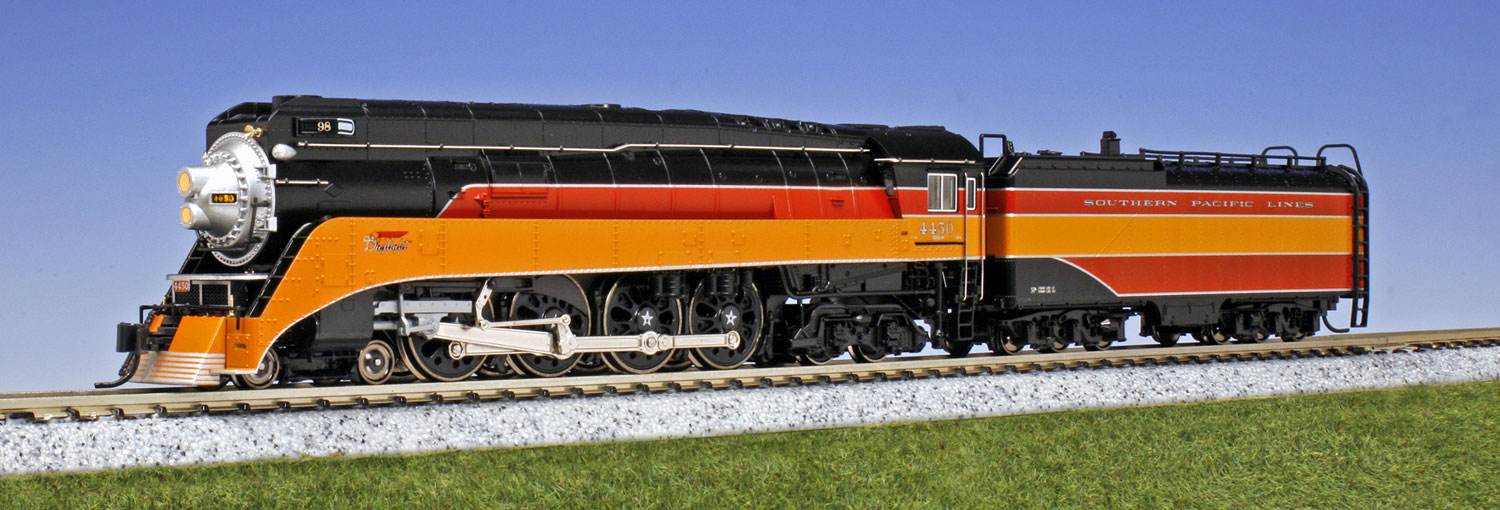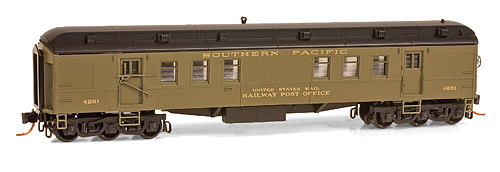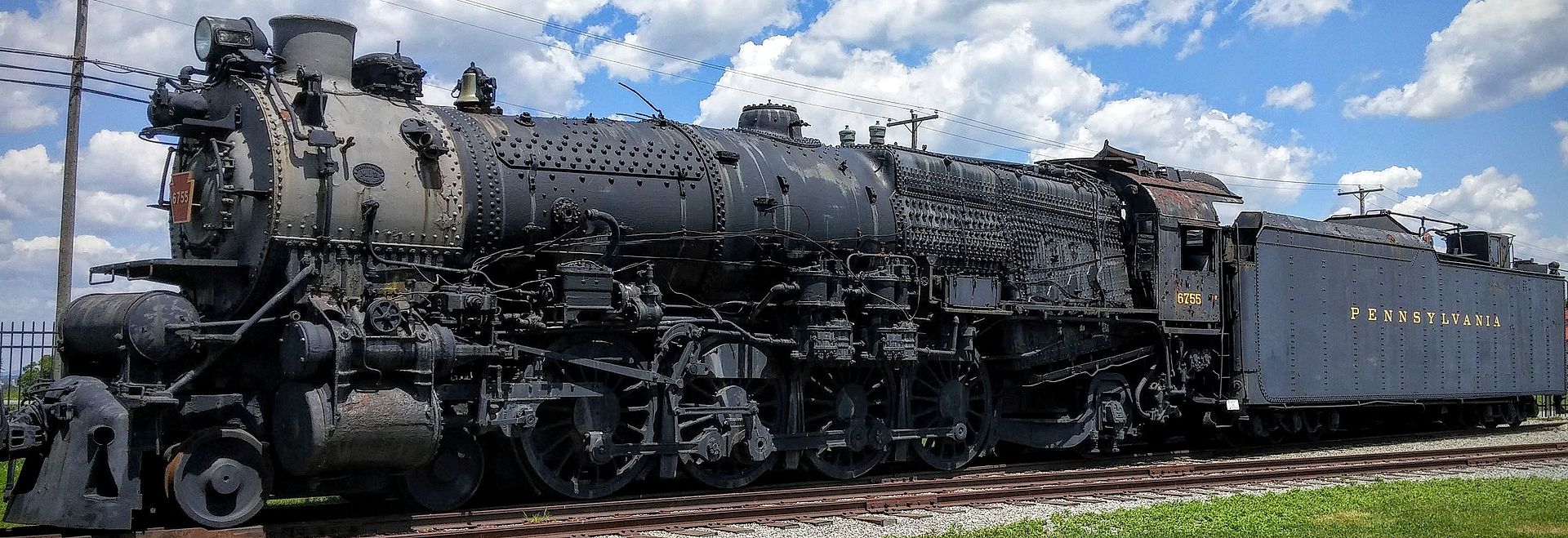Model Information: Locomotive features:
- Paragon2 Sound & Control System
- Integral DCC Decoder with Back EMF for Industry Best Slow Speed Operation in DC and DCC
- Motor Type: 5-Pole Can with Skewed Armature & Fly Wheels
- Authentic PRR M1a Sounds (on sound-equipped units)
- Premium Caliber Painting with Authentic Paint Schemes
- Prototypical Light Operation with Golden White LED Headlight and Reverse Light Jewel
- Beautifully Detailed, Accurately Modeled Locomotive
- Separately Applied Details such as brass bell, grab irons, and ladders
- Constant Intensity Directional Lighting
- Locomotive Composition: ABS plastic with Die Cast Chassis
- Tender Composition: ABS plastic with Die Cast Chassis
- Locomotive Length: 6.5 inches
- Tender Length: 3.8 inches
- Couplers: 1 rear Microtrains #1015 compatible & Dummy front coupler
- Recommended Minimum Radius: 9.75 inches
Prototype History: Under the Whyte notation for the classification of steam locomotives, 4-8-2 represents the wheel arrangement of four leading wheels, eight powered and coupled driving wheels and two trailing wheels. This type of steam locomotive is commonly known as the Mountain type.
One of the largest users in the United States was the Pennsylvania Railroad with 224 Class M1, Class M1a and Class M1b locomotives that were used mostly for fast freight service. A single prototype, #6699, was built in 1923 at the railroad's Altoona Works. It spent three years in testing, including all kinds of main line service as well as a session on the railroad's static test plant. Having received favorable reports, a further 200 were ordered from commercial locomotive builders; 175 from the Baldwin Locomotive Works and 25 from Lima Locomotive Works. Breaking with the PRR tradition of random locomotive numbering, these were numbered in a solid block from #6800-#6999.
In 1930 100 more were ordered; this class M1a had several improvements. Instead of separate cylinder block and smokebox saddle castings, the M1a had a one-piece casting (first seen on the K5 Pacific) with inside steam delivery pipes, instead of the outside, visible pipes of the M1. A Worthington feedwater heater was installed, with a boxlike mixing chamber behind the stack. Twin cross-compound air compressors were hung next to each other on the left side, instead of the single compressor of the M1. The M1a locomotives had larger tenders than the previous locomotives.
From Wikipedia
One of the largest users in the United States was the Pennsylvania Railroad with 224 Class M1, Class M1a and Class M1b locomotives that were used mostly for fast freight service. A single prototype, #6699, was built in 1923 at the railroad's Altoona Works. It spent three years in testing, including all kinds of main line service as well as a session on the railroad's static test plant. Having received favorable reports, a further 200 were ordered from commercial locomotive builders; 175 from the Baldwin Locomotive Works and 25 from Lima Locomotive Works. Breaking with the PRR tradition of random locomotive numbering, these were numbered in a solid block from #6800-#6999.
In 1930 100 more were ordered; this class M1a had several improvements. Instead of separate cylinder block and smokebox saddle castings, the M1a had a one-piece casting (first seen on the K5 Pacific) with inside steam delivery pipes, instead of the outside, visible pipes of the M1. A Worthington feedwater heater was installed, with a boxlike mixing chamber behind the stack. Twin cross-compound air compressors were hung next to each other on the left side, instead of the single compressor of the M1. The M1a locomotives had larger tenders than the previous locomotives.
From Wikipedia
Road Name History: The Pennsylvania Railroad (reporting mark PRR) was an American Class I railroad, founded in 1846. Commonly referred to as the "Pennsy," the PRR was headquartered in Philadelphia, Pennsylvania.
The PRR was the largest railroad by traffic and revenue in the U.S. for the first half of the twentieth century. Over the years, it acquired, merged with or owned part of at least 800 other rail lines and companies. At the end of 1925, it operated 10,515 miles of rail line; in the 1920s, it carried nearly three times the traffic as other railroads of comparable length, such as the Union Pacific or Atchison, Topeka & Santa Fe railroads. Its only formidable rival was the New York Central (NYC), which carried around three-quarters of PRR's ton-miles.
At one time, the PRR was the largest publicly traded corporation in the world, with a budget larger than that of the U.S. government and a workforce of about 250,000 people. The corporation still holds the record for the longest continuous dividend history: it paid out annual dividends to shareholders for more than 100 years in a row.
In 1968, PRR merged with rival NYC to form the Penn Central Transportation Company, which filed for bankruptcy within two years. The viable parts were transferred in 1976 to Conrail, which was itself broken up in 1999, with 58 percent of the system going to the Norfolk Southern Railway (NS), including nearly all of the former PRR. Amtrak received the electrified segment east of Harrisburg.
The PRR was the largest railroad by traffic and revenue in the U.S. for the first half of the twentieth century. Over the years, it acquired, merged with or owned part of at least 800 other rail lines and companies. At the end of 1925, it operated 10,515 miles of rail line; in the 1920s, it carried nearly three times the traffic as other railroads of comparable length, such as the Union Pacific or Atchison, Topeka & Santa Fe railroads. Its only formidable rival was the New York Central (NYC), which carried around three-quarters of PRR's ton-miles.
At one time, the PRR was the largest publicly traded corporation in the world, with a budget larger than that of the U.S. government and a workforce of about 250,000 people. The corporation still holds the record for the longest continuous dividend history: it paid out annual dividends to shareholders for more than 100 years in a row.
In 1968, PRR merged with rival NYC to form the Penn Central Transportation Company, which filed for bankruptcy within two years. The viable parts were transferred in 1976 to Conrail, which was itself broken up in 1999, with 58 percent of the system going to the Norfolk Southern Railway (NS), including nearly all of the former PRR. Amtrak received the electrified segment east of Harrisburg.
Brand/Importer Information:  Broadway Limited Imports, LLC defines itself as "the world's foremost producer of top-quality HO and N scale model trains".
Broadway Limited Imports, LLC defines itself as "the world's foremost producer of top-quality HO and N scale model trains".
The company was founded in 2002 and introduced its first N scale model in 2009.
Broadway Limited Imports is composed of a team of 15 fun loving individuals who are dedicated to creating the most realistic model railroading experience possible, with the best customer service possible.
The Broadway Limited Imports headquarters is located in Ormond Beach, Florida at 9 East Tower Circle. It's just under an hour's drive from Disney World.
About Broadway Limited Imports.

The company was founded in 2002 and introduced its first N scale model in 2009.
Broadway Limited Imports is composed of a team of 15 fun loving individuals who are dedicated to creating the most realistic model railroading experience possible, with the best customer service possible.
The Broadway Limited Imports headquarters is located in Ormond Beach, Florida at 9 East Tower Circle. It's just under an hour's drive from Disney World.
About Broadway Limited Imports.
Item created by: gdm on 2017-11-15 20:19:33
If you see errors or missing data in this entry, please feel free to log in and edit it. Anyone with a Gmail account can log in instantly.
If you see errors or missing data in this entry, please feel free to log in and edit it. Anyone with a Gmail account can log in instantly.









